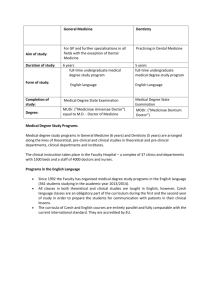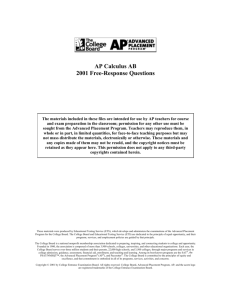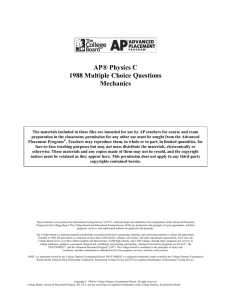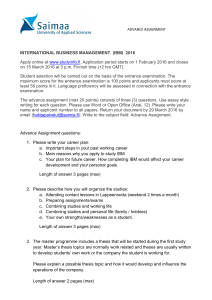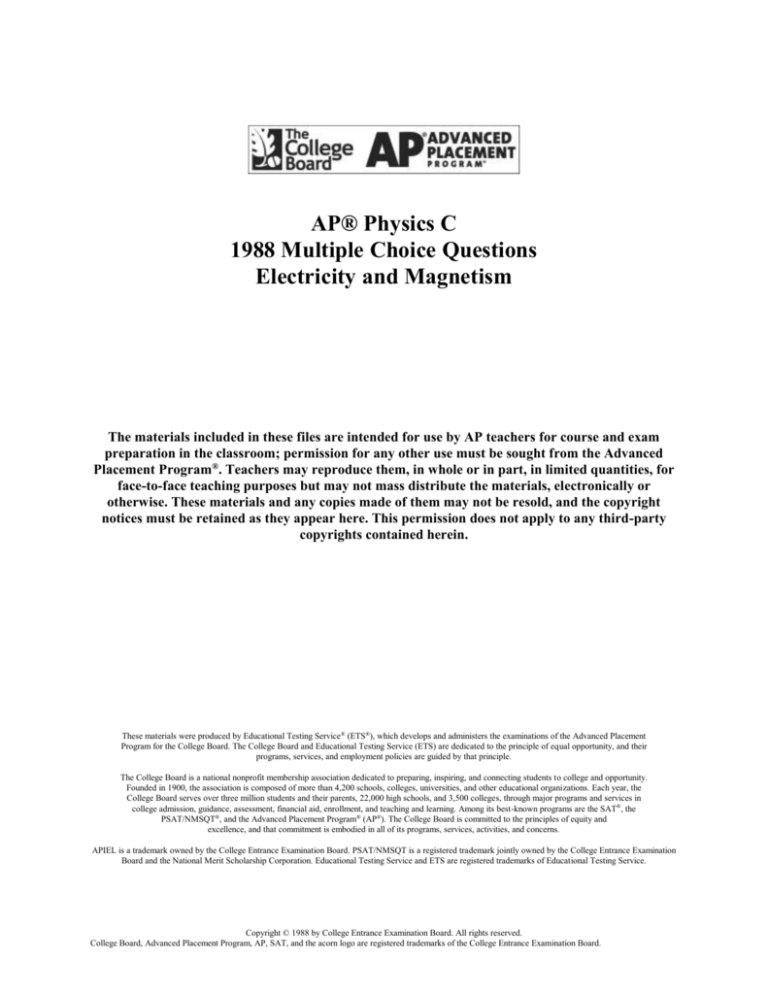
AP® Physics C
1988 Multiple Choice Questions
Electricity and Magnetism
The materials included in these files are intended for use by AP teachers for course and exam
preparation in the classroom; permission for any other use must be sought from the Advanced
Placement Program®. Teachers may reproduce them, in whole or in part, in limited quantities, for
face-to-face teaching purposes but may not mass distribute the materials, electronically or
otherwise. These materials and any copies made of them may not be resold, and the copyright
notices must be retained as they appear here. This permission does not apply to any third-party
copyrights contained herein.
These materials were produced by Educational Testing Service® (ETS®), which develops and administers the examinations of the Advanced Placement
Program for the College Board. The College Board and Educational Testing Service (ETS) are dedicated to the principle of equal opportunity, and their
programs, services, and employment policies are guided by that principle.
The College Board is a national nonprofit membership association dedicated to preparing, inspiring, and connecting students to college and opportunity.
Founded in 1900, the association is composed of more than 4,200 schools, colleges, universities, and other educational organizations. Each year, the
College Board serves over three million students and their parents, 22,000 high schools, and 3,500 colleges, through major programs and services in
college admission, guidance, assessment, financial aid, enrollment, and teaching and learning. Among its best-known programs are the SAT®, the
PSAT/NMSQT®, and the Advanced Placement Program® (AP®). The College Board is committed to the principles of equity and
excellence, and that commitment is embodied in all of its programs, services, activities, and concerns.
APIEL is a trademark owned by the College Entrance Examination Board. PSAT/NMSQT is a registered trademark jointly owned by the College Entrance Examination
Board and the National Merit Scholarship Corporation. Educational Testing Service and ETS are registered trademarks of Educational Testing Service.
Copyright © 1988 by College Entrance Examination Board. All rights reserved.
College Board, Advanced Placement Program, AP, SAT, and the acorn logo are registered trademarks of the College Entrance Examination Board.
36. Two small spheres have equal charges q and are separated by a distance d. The force exerted on each sphere by
the other has magnitude F. If the charge on each sphere is doubled and d is halved, the force on each sphere has
magnitude
(A) F
(B) 2F
(C) 4F
(D) 8F
(E) 16F
37. Which of the following statements about conductors under electrostatic conditions is true?
(A) Positive work is required to move a positive charge over the surface of a conductor.
(B) Charge that is placed on the surface of a conductor always spreads evenly over the surface.
(C) The electric potential inside a conductor is always zero.
(D) The electric field at the surface of a conductor is tangent to the surface.
(E) The surface of a conductor is always an equipotential surface.
38. A charged particle traveling with a velocity v in an electric field E experiences a force F that must be
(A) parallel to v (B) perpendicular to v (C) parallel to v x E (D) parallel to E (E) perpendicular to E
39. Two resistors of the same length, both made of the same material, are connected in a series to a battery as shown
above. Resistor II has a greater cross. sectional area than resistor I. Which of the following quantities has the
same value for each resistor?
(A) Potential difference between the two ends
(B) Electric field strength within the resistor
(C) Resistance
(D) Current per unit area
(E) Current
40. A positive charge of 3.0 x 10-8 coulomb is placed in an upward directed uniform electric field of 4.0 x 10 4N/c.
When the charge is moved 0.5 meter upward, the work done by the electric force on the charge is
(A) 6 x 10-4 J
(B) 12 x 10-4 J
(C) 2 x 104 J (D) 8 x 104 J
(E) 12 x 104 J
41. Which of the following can be used along with fundamental constants, but no other quantities, to calculate the
magnitude of the electric field between the plates of a parallel-plate capacitor whose plate dimensions and
spacing are not known?
(A) The flux between the plates
(B) The total charge on either plate
(C) The potential difference between the plates (D) The surface charge density on either plate
(E) The total energy stored in the capacitor
42. Two very long parallel wires carry equal currents in the same direction into the page, as shown above. At point
P, which is 10 centimeters from each wire, the magnetic field is
(A) zero
(B) directed into the page
(C) directed out of the page (D) directed to the left
(E) directed to the right
43. When two identical parallel-plate capacitors are connected in series, which of the following is true of the
equivalent capacitance?
(A) It depends on the charge on each capacitor.
Copyright © 1988 by College Entrance Examination Board. All rights reserved.
College Board, Advanced Placement Program, AP, SAT, and the acorn logo are registered trademarks of the College Entrance Examination Board.
(B) It depends on the potential difference across both capacitors.
(C) It is larger than the capacitance of each capacitor.
(D) It is smaller than the capacitance of each capacitor.
(E) It is the same as the capacitance of each capacitor.
Questions 44-45
A proton traveling with speed v enters a uniform electric field of magnitude E, directed parallel to the plane of the
page, as shown in the figure above. There is also a magnetic force on the proton that is in the direction opposite to
that of the electric force.
44. Which of the following is a possible direction for the magnetic field?
(A)
(B)
(C)
(D) (directed out of the page)
(E) (directed into the page)
45. If e represents the magnitude of the proton charge, what minimum magnitude of the magnetic field could
balance the electric force on the proton?
(A) E/v
(B) eE/v
(C) vE
(D) eE
(E) evE
46. At time t = 0 the switch is closed in the circuit shown above. Which of the following graphs best describes the
potential difference V, across the resistance as a function of time t ?
Copyright © 1988 by College Entrance Examination Board. All rights reserved.
College Board, Advanced Placement Program, AP, SAT, and the acorn logo are registered trademarks of the College Entrance Examination Board.
Questions 47-48 relate to the following configurations of electric charges located at the vertices of an equilateral
triangle. Point P is equidistant from the charges.
47. In which configuration is the electric field at P equal to zero?
(A)
(B)
(C)
(D)
(E)
48. In which configuration is the electric field at P pointed at the midpoint between two of the charges?
(A)
(B)
(C)
(D)
(E)
49. Two square parallel-plate capacitors of capacitances C1 and C2 have the dimensions shown in the diagrams
above. The ratio of C1 to C2 is
(A) 1 to 4
(B) 1 to 2
(C) 1 to 1 (D) 2 to 1
(E) 4 to 1
50. A current I, uniformly distributed over the cross section of a long cylindrical conductor of radius a, is directed as
shown above. Which of the following graphs best represents the intensity B of the magnetic field as a function of
the distance r from the axis of the cylinder?
Copyright © 1988 by College Entrance Examination Board. All rights reserved.
College Board, Advanced Placement Program, AP, SAT, and the acorn logo are registered trademarks of the College Entrance Examination Board.
51. At point X a charged particle has a kinetic energy of 9 microjoules ( J ). It follows the path shown above from
X to Y through a region in which there is an electric field and a magnetic field. At Y the particle has a kinetic
energy of 11 J. What is the work done by the magnetic field on the particle?
(A) 11 J
(B) 2 J
(C) - 2 J
(D) -11 J
(E) None of the above
52. In a region of space there is a uniform B field in the plane of the page but no E field. A positively charged
particle with velocity v directed into the page is subject to a force F in the plane of the page as shown above.
Which of the following vectors best represents the direction of B?
(A)
(B)
(C)
(D)
(E)
53. Two conducting spheres, X and Y. have the same positive charge +Q, but different radii (r x > ry) as shown
above. The spheres are separated so that the distance between them is large compared with either radius. If a
wire is connected between them, in which direction will current be directed in the wire?
(A) From X to Y
(B) From Y to X
(C) There will be no current in the wire.
(D) It cannot be determined without knowing the magnitude of Q.
(E) It cannot be determined without knowing whether the spheres are solid or hollow.
54. The emf of a battery is 12 volts. When the battery delivers a current of 0.5 ampere to a load, the potential
difference between the terminals of the battery is 10 volts. The internal resistance of the battery is
(A) 1
(B) 2
(C) 4
(D) 20
(E) 24
55. A square loop of wire of side 0.5 meter and resistance 10 -2 ohm is located in a uniform magnetic field of
intensity 0.4 tesla directed out of the page as shown above. The magnitude of the field is decreased to zero at a
constant rate in 2 seconds. As the field is decreased, what are the magnitude and direction of the current in the
loop?
(A) Zero
(B) 5 A, counterclockwise (C) 5 A, clockwise (D) 20 A, counterclockwise (E) 20 A,
clockwise
Copyright © 1988 by College Entrance Examination Board. All rights reserved.
College Board, Advanced Placement Program, AP, SAT, and the acorn logo are registered trademarks of the College Entrance Examination Board.
Questions 56-57 refer to a sphere of radius R that has positive charge Q uniformly distributed on its surface
56. Which of the following represents the magnitude of the electric field E and the potential V as functions of r, the
distance from the center of the sphere, when r < R ?
E
V
(A) 0
kQ/R
(B) 0
kQ/r
(C) 0
0
(D) kQ/r2 0
(E) kQ/R2 0
57. Which of the following represents the magnitude, of the electric field E and the potential V as functions of r, the
distance from the center of sphere, when r > R ?
E
V
(A) kQ/R2 kQ/R
(B) kQ/R kQ/R
(C) kQ/R kQ/r
(D) kQ/r2 kQ/r
(E) kQ/r2 kQ/r2
58. If R is 1 ohm and L is 1 henry, then L/R is
(A) 1 volt
(B) 1 farad
(C) 1 ampere
(D) 1 coulomb
(E) 1 second
59. A negatively charged particle in a uniform magnetic field B moves with constant speed v in a circular path of
radius r, as shown above. Which of of following graphs best represents the radius r as a function of the
magnitude of B, if the speed v is constant?
Copyright © 1988 by College Entrance Examination Board. All rights reserved.
College Board, Advanced Placement Program, AP, SAT, and the acorn logo are registered trademarks of the College Entrance Examination Board.
60. In the circuit shown above, the capacitor is initially uncharged. At time t = 0, switch S is closed. The natural
logarithmic base is e. Which of the following is true at time t = RC?
(A) The current is /eR .
(B) The current is /R
(D) The voltage across the capacitor is /e .
(C) The voltage across the capacitor is .
(E) The voltages across the capacitor and resistor are equal.
61. Which of the following equations implies that it is impossible to isolate a magnetic pole?
E dA q / (B) E dl d / dt (C) B dA 0
B dl i d / dt
(D)
(E) None of the above
0
(A)
0
E
0
0
E
Questions 62-63 refer to the diagram below of two conducting loops having a common axis.
62. After the switch S is closed, the current through resistor R2 is
(A) from point X to point Y
(B) from point Y to point X
(C) zero at all times
(D) oscillating with decreasing amplitude
(E) oscillating with constant amplitude
63. After the switch S has been closed for a very long time, the currents in the two circuits are
(A) zero in both circuits
(B) zero in circuit 1 and V/R 2 in circuit 2
(C) V/R1 in circuit 1 and zero in circuit 2
(D) V/R1 in circuit I and V/R2 in circuit 2
(E) oscillating with constant amplitude in both circuits
Questions 64-65 relate to the two long parallel wires shown below. Initially the wires arc a distance d apart and each
has a current i directed into the page. The force per unit length on each wire has magnitude Fo
64. The direction of the force on the right-hand wire due to the current in the left-hand wire is
(A) to the right
(B) to the left
(C) upward in the plane of the page
(D) downward in the plane of the page
(E) into the page
65. The wires are moved apart to a separation 2d and the current in each wire is increased to 2i. The new force per
unit length on each wire is
(A) F0/4
(B) Fo/2
(C) Fo
(D) 2Fo
(E) 4Fo
Copyright © 1988 by College Entrance Examination Board. All rights reserved.
College Board, Advanced Placement Program, AP, SAT, and the acorn logo are registered trademarks of the College Entrance Examination Board.
Questions 66-67
Positive charge Q is uniformly distributed over a thin ring of radius a that lies in a plane perpendicular to the x-axis.
with its center at the origin 0, as shown above.
66. The potential V at points on the x-axis is represented by which of the following functions?
kQ
2
x a2
(A)
kQ
V (x )
ax
V (x )
V (x )
(B)
kQ
a x
2
2
V (x )
(C)
kQ
x2
V (x )
(D)
kQ
x
( E)
67. Which of the following graphs best represents the electric field along the positive x-axis?
68. In the circuit shown above, the emf's of the batteries are given, as well as the currents in the outside branches
and the resistance in the middle branch. What is the magnitude of the potential difference between X and Y ?
(A) 4 V
(B) 8 V
(C) 10 V
(D) 12 V
(E) 16 V
69. Two identical parallel conducting rings have a common axis and are separated by a distance a, as shown above.
The two rings each carry a current I, but in opposite directions. At point P, the center of the ring on the left the
magnetic field due to these currents is
(A) zero
(B) in the plane perpendicular to the x-axis
(C) directed in the positive x-direction
(D) directed in the negative x-direction
(E) none of the above
Copyright © 1988 by College Entrance Examination Board. All rights reserved.
College Board, Advanced Placement Program, AP, SAT, and the acorn logo are registered trademarks of the College Entrance Examination Board.
70. A sheet of mica is inserted between the plates of an isolated charged parallel-plate capacitor. Which of the
following statements is true?
(A) The capacitance decreases.
(B) The potential difference across the capacitor decreases.
(C) The energy of the capacitor does not change.
(D) The charge on the capacitor plates decreases
(E) The electric field between the capacitor plates increases.
Copyright © 1988 by College Entrance Examination Board. All rights reserved.
College Board, Advanced Placement Program, AP, SAT, and the acorn logo are registered trademarks of the College Entrance Examination Board.


